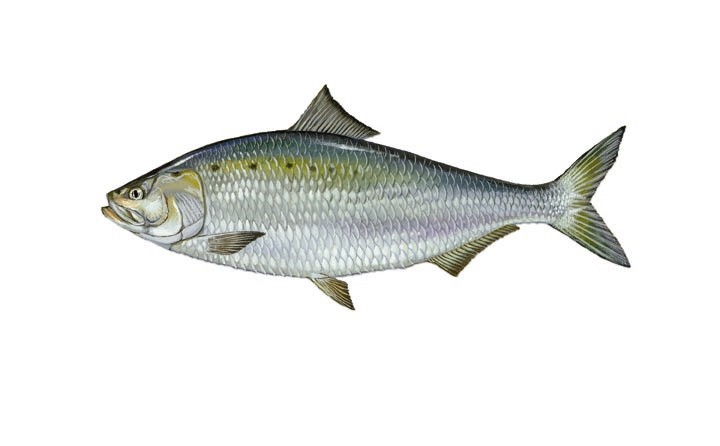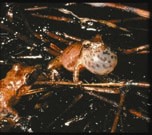Chesapeake Spring
By Kathy Reshetiloff
As we emerge from winter the skies, waterways and land are bursting with plants and animals heralding the coming of spring. Plants are the first indicators that seasons are changing as tightly-packed buds begin to slowly unfurl their green treasures.
One of the earliest plants, skunk cabbage (Symplocarpus foetidus), appears as early as February, often popping up through snow. In fact, respiration from skunk cabbage can create enough heat to melt any snow surrounding the plant.
 Skunk cabbage is a low-growing plant found in swamps, wet woods and stream borders. The name comes from the plant's large, cabbage-like leaves and strong, fetid smell emitted when certain parts of the plant are touched or bruised. The plant mimics this putrid smell in order to attract flies to help to pollinate the plant. Skunk cabbage is a low-growing plant found in swamps, wet woods and stream borders. The name comes from the plant's large, cabbage-like leaves and strong, fetid smell emitted when certain parts of the plant are touched or bruised. The plant mimics this putrid smell in order to attract flies to help to pollinate the plant.
Another sign of spring is the creamy white blossoms of the serviceberry tree (Amelanchier spp.). The flowers appear prior to many other flowering trees, making them quite conspicuous against the background of a still gray forest.
There are about a dozen Amelanchier species native to the United States. They range from low spreading shrubs to tall trees. The downy serviceberry or shadbush is a small tree that begins blooming in March.
The name serviceberry probably originated from a Colonial tradition. After the spring thaw, clergy would ride a circuit through mountainous regions to provide services to those who had died that past winter. This circuit usually coincided with the blooming of serviceberry. Also known as shadbush, flowering occurs around the same time as fish - like shad - return to their springtime spawning grounds.
Most of the year shad inhabit offshore Atlantic waters. Warming temperatures and lengthening days prompt them to swim up the Chesapeake Bay to freshwater to spawn, usually returning to the same river in which they were born. How they do this remains a mystery. Many scientists believe that this homing instinct may be due to an uncanny sense of smell and sensitivity to magnetic signals, polarized light and unique characteristics of the natal stream.
Alewife (Alosa pseudoharengus), hickory shad (Alosa mediocris) and American shad (Alosa sapidissima) generally spawn from March through June while blueback herring (Alosa aestivalis) begin in April.
 Other wildlife are also returning from long migrations. Absent from buoys, bridges and channel markers, ospreys (Pandion haliaetus) are coming back to the Chesapeake Bay. As with many other migratory birds, they spent the past winter in the Caribbean, and Central and South America. Other wildlife are also returning from long migrations. Absent from buoys, bridges and channel markers, ospreys (Pandion haliaetus) are coming back to the Chesapeake Bay. As with many other migratory birds, they spent the past winter in the Caribbean, and Central and South America.
Ospreys usually mate for life, and will use the same nest site year after year. Upon returning to the Chesapeake Bay each spring, reunited pairs begin the task of nest building or repair. Younger, first-time nesters must first attract and court a mate. Spring courtship marks the beginning of a five-month period when the pair works together to raise their young.
But for me, I know that spring has sprung the first time I hear spring peepers (Hyla crucifer crucifer). Like other frogs, male peepers sing to attract females. The mating call, a high-pitched ascending whistle, can sometimes be heard up to a one half a mile away. From February to March, spring peepers leave the trees to mate in open water. Temporary ponds in forested wetlands are the main breeding sites. These ponds may last a few days or a few weeks but are critical to the life cycle of peepers and other amphibians.
Peeper breeding actually follows the wood frog by a week or two. Its unmistakable mating call and large range make the spring peeper one of the most familiar frogs in North America.
These are our harbingers of spring. It's hard to imagine our world without them. But no matter how common they seem, their survival is not guaranteed. As long as we continue to protect and restore the wetlands, forests and waterways these plants and animals need to live and breed, they will continue to return to grace our lives.
What you can do:
. Conserve water and energy
. Remove invasive plants from
your property
. Replace traditional landscap-
ing with native plants
. Reduce your use of nutrients,
pesticides and herbicides
. Get involved with organiza-
tions dedicated to conserving
habitat
Back
|

